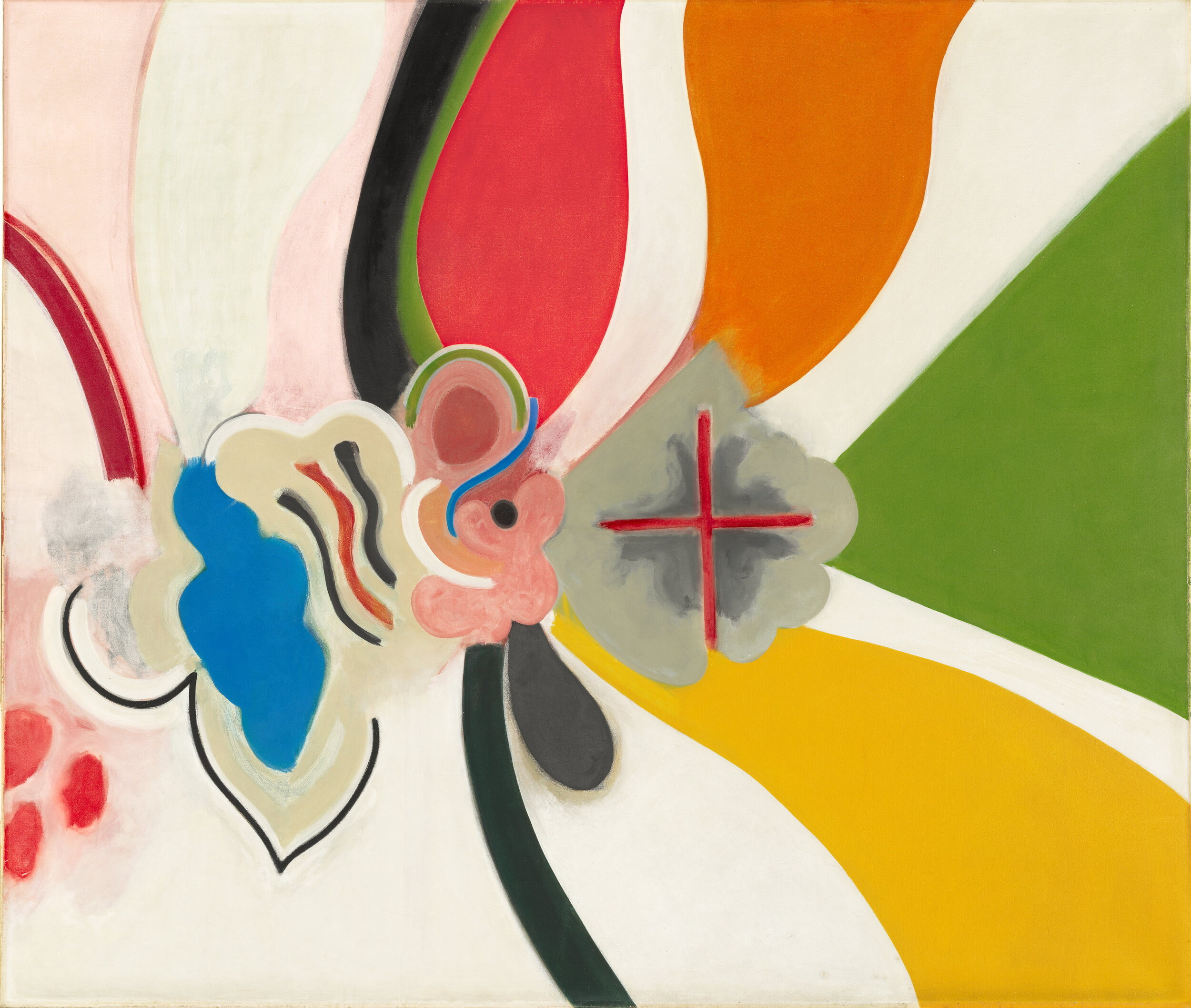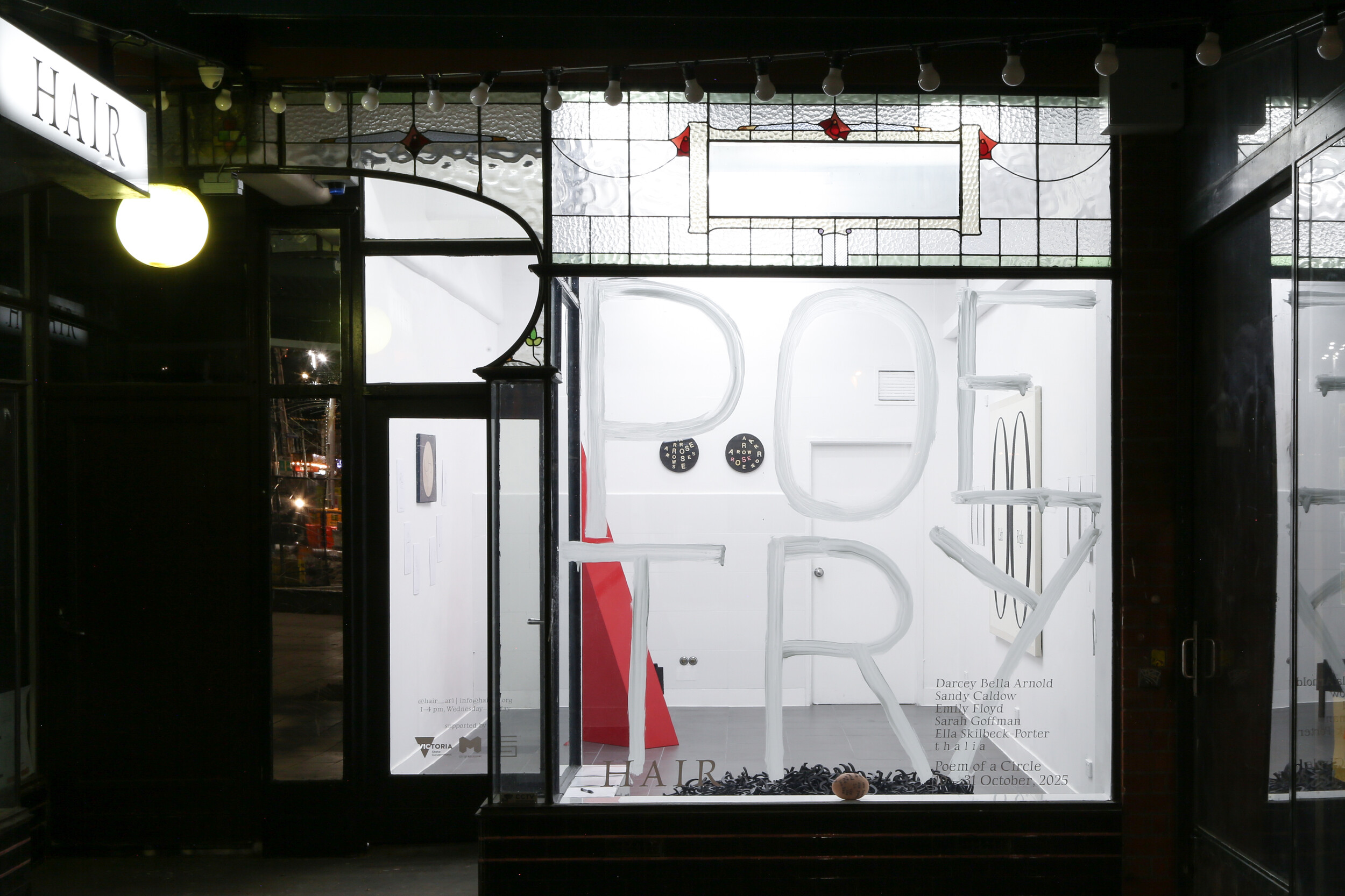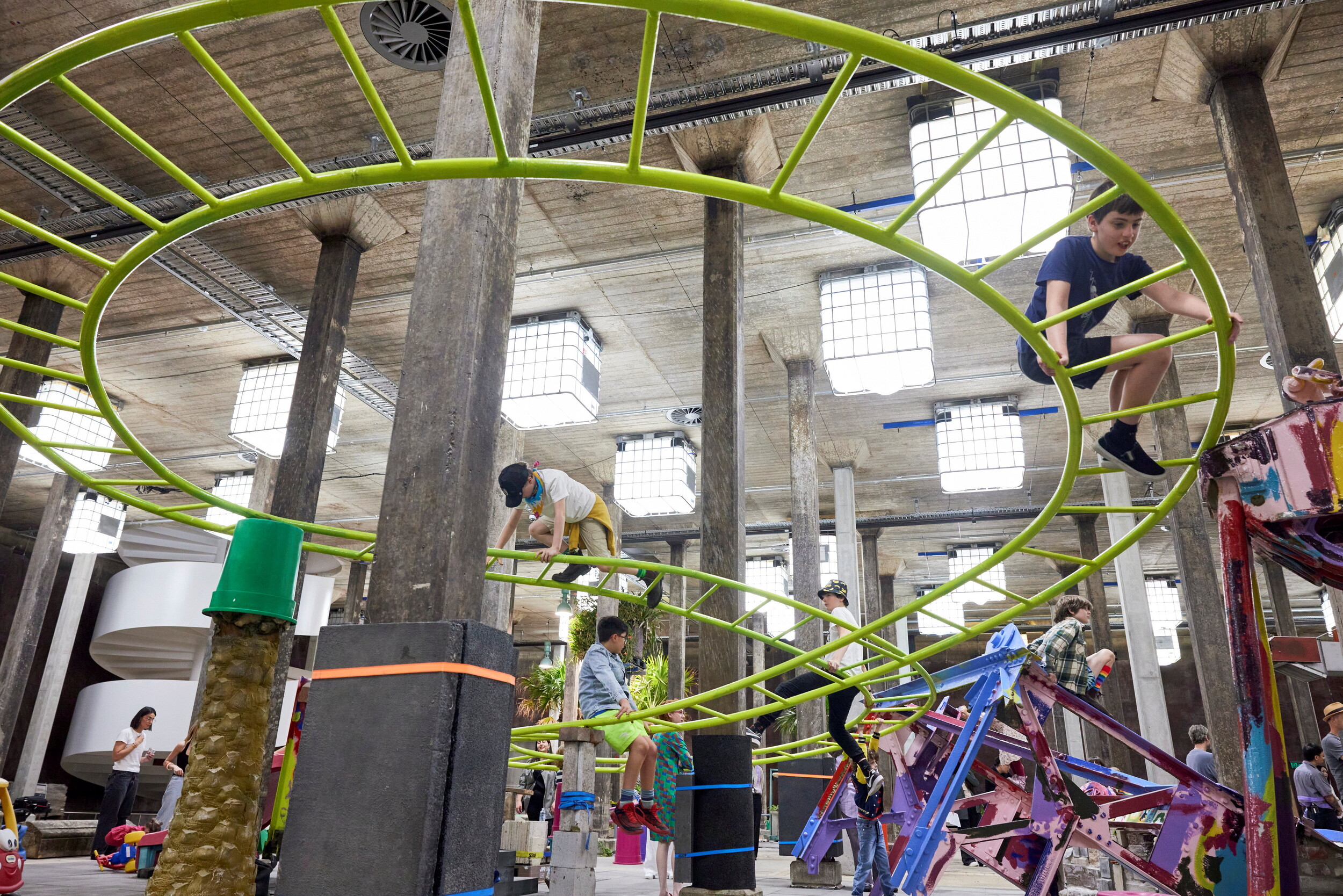Tschabalala Self, Candy 2021, installation view, Australian Centre for Contemporary Art, Melbourne, 2025. Courtesy the artist and Longlati Foundation. Photograph: Andrew Curtis
Skin Tight
Hugh Magnus
And they were both naked, the man and his wife, and were not ashamed.
Genesis 2:25
My eyes land on the woman’s breasts: her nipples stare back at me, like the ocelli on a moth’s wings. Her eyes are closed, avoiding my gaze. Her male companion is similarly exposed, his outsized hands ironically covering little. While this sounds like I’m playing Peeping Tom, I’m actually at American artist Tschabalala Self’s solo show, Skin Tight, at the Australian Centre for Contemporary Art (ACCA). I’m standing in front of Dreamers (2021), a monumental diptych four-and-a-half metres across, hung at the precise height for me to make this observation. The subjects of Dreamers challenge my gaze, making me painfully aware of the way in which I look at not only them, but all the figures portrayed in the show.
Self is ostensibly a portrait artist. But rather than using portraiture to conventional ends, she depicts imagined figures through a signature style of paint and quilted fabric on canvas. Bodies are patched together, some delicately detailed, some crude, but all fragmented. “Having a figure made of all these disparate things—a kaleidoscope of elements—truly reflects the complexity of the human experience better than any photo or traditional painting could,” the artist claims. While the Franken-bodies of Self’s assemblages resist objectification and conventional beauty standards, and have no shortage of material interest, this statement is a bold assertion.
What we might say instead is that Self’s work fits within a broader, rich tradition of black quilting and collage in America, one that encompasses the women of Gee’s Bend in Mississippi and Harlem dwellers Romare Bearden and Faith Ringgold. Self grew up in Harlem, and remains connected to the New York suburb’s legacy of black creativity. But where Ringgold’s narrative quilts are tight and precise, Self’s figures have a grotesquerie more suggestive of the work of Francis Bacon, an expressive, unsettling touch. And while the explicitness of Self’s work is oft commented upon—Kate Sutton of Artforum once described Self’s work as “an army of swooning calves, nipples like ten-gallon hats, and pussies like peach pits amid voluminous hips”—I don’t register much shock value in Dreamers, nor in the rest of the exhibition. Rather, the naked body is positioned simply as a fact of nature; a celebration of blackness and a repudiation of hyper-sexual stereotypes. All the figures in Skin Tight are confident and self-assertive, daring us to pass judgement.
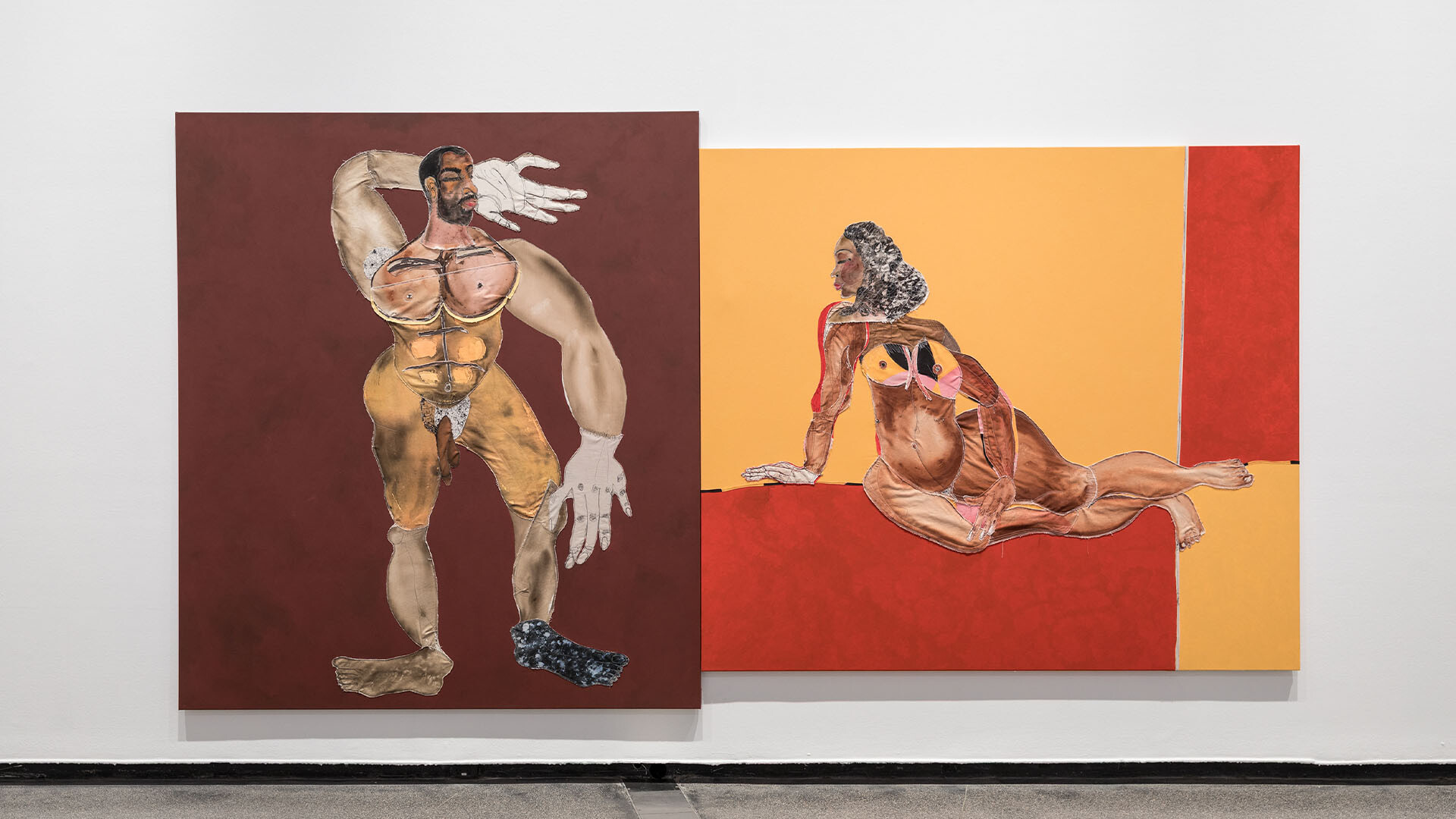
Tschabalala Self, Dreamers (diptych) 2021, installation view, Australian Centre for Contemporary Art, Melbourne, 2025. Courtesy the artist, Pilar Corrias, London, Galerie Eva Presenhuber, Zurich / Vienna and Petzel Gallery, New York. Photograph: Andrew Curtis.
Skin Tight is the inaugural show curated by ACCA’s first millennial director, Myles Russell-Cook (alongside Senior Curator Shelley McSpedden). Russell-Cook’s three-year program—announced with a fundraising dinner and flashy newspaper earlier this year—is both a departure from his earlier work (as senior curator of Australian and First Nations art at the NGV) and the approach of his predecessor at ACCA, Max Delany. It’s interesting to get a sense of Russell-Cook’s style out of the confines of the NGV, with a broader remit and more artistic freedom. This exhibition thus feels like a bit of a litmus test for what we should be expecting over the next few years. Millennial artists, especially those from North America, feature heavily in the programming: Self joins the artist and activist Tourmaline (expect a Marsha P. Johnson tribute) and the Cree painter Kent Monkman with solo shows. Closer to home, Zaachariaha Fielding and r e a are too afforded solos, although the broader lack of Australian talent in the program has raised a few eyebrows. An annual series of emotion-themed group exhibitions (Loneliness, Rage and Joy) feature artists both familiar (Yoko Ono, naturally) and unexpected (Lucy Liu, of Charlie’s Angels and Kill Bill fame!).
Despite Delany’s hand in commissioning the show, one could be forgiven for thinking that Skin Tight is all the work of Russell-Cook, whose program preview sent a strong signal that he seeks to usher in the spectacular, immersive house style of the NGV. In this show, this happens largely through chic wall treatments (stripes, chequerboards, and stretched lozenges that respond to motifs in Self’s work) and an expansive PR campaign. For Skin Tight, Russell-Cook has joined forces with Vogue as ACCA’s new, ongoing media partner: the director’s interview with Self appeared in September in the pages of Vogue Australia. The artist also designed an online cover for the US magazine back in 2023, a self assured portrait of the pop star Nicki Minaj, which unfortunately did not make it into this show. It’s clear Self is the dernier cri: while the artist is not well known in the Antipodes, she’s a glamorous rising star in the States. With collaborations with Ugg and Louis Vuitton under her belt, and her July Hudson Valley wedding also featured in American Vogue, Self feels more like a conventional celebrity than most artists featured at ACCA in the past.
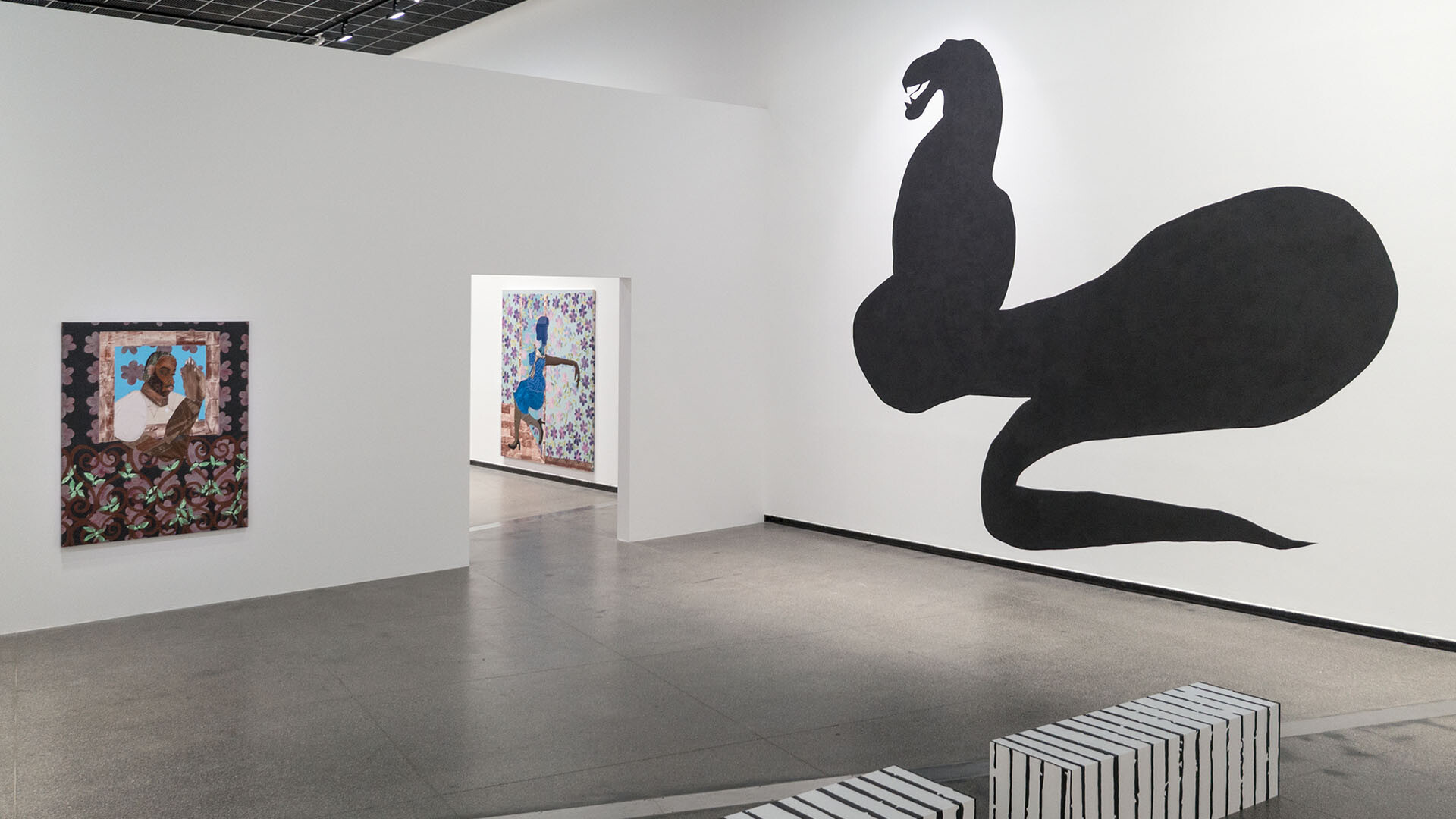
Skin Tight installation view, Australian Centre for Contemporary Art, Melbourne, 2025. Photograph: Andrew Curtis.
Shadows and reflections feature heavily in Skin Tight, both in the works themselves and the curation of the show. This has been done particularly successfully in ACCA’s second gallery, where two works both entitled Snake (2025) face off. The first—a silhouetted mural of a serpent painted with the assistance of VCA staff and students—soars up several metres, bulging menacingly. The second Snake, a work on canvas, is hung directly opposite: a less imposing albeit still sinister presence. The fabric of the snake’s body has been treated particularly masterfully, with a sheer, black polka-dotted gauze over another material, giving the work depth and intrigue. This latter Snake is also in dialogue with Reclining Woman (2025), which is hung next to it—the shape of the woman precisely mirroring the curves of the serpent. Snake is also contextualised by Adam and Eve (2025), a diptych on the adjacent wall. Here, the didactic gives context to the striped walls in the first two galleries:
Similar to a checker board, the stripes have a yin and yang relationship. They are opposing yet conjoined, working in cycles with one another, like the sun and moon, when combined these forces create the totality of our universe.
I’m not so sure about this: the stripes are a fun, decorative background for the work, but it’s hard to make this cosmic connection even when prompted. What becomes clear reading this didactic is that the “yin and yang relationship” is the underpinning philosophy of Skin Tight: that is, that opposites (and mirror images, shadows etc.) come together to create unified wholes. In Lacanian terms, the visual identity supplied by the mirror gives an imaginary unity to the experience of the real, fragmented body. While Self’s bodies are literally, rather than psychologically fragmented, the shadow-murals and the mirroring within the show still fulfil an unaddressed Lacanian sensitivity. But suggesting that the wall stripes are doing that too? A bit of a stretch. Adam and Eve is a good work though. The two canvases, again, mirror one another. Patchwork Adam reaches out to patchwork Eve, who holds the untouched apple behind her. Rather than biting in, she seems to be concealing the fruit: a tense moment before the fall. Both figures are presented against a bed of green leaves on a lurid orange background. If any other painter were to use this many complementary colours I think I’d get a headache, but it fits well with the broader energy and vibrancy of Self’s work. On the last wall of the same gallery, Man in Frame (2025) portrays a detailed man in prayer, a Memling-esque composition framed with a plum wallpaper of flowers and curlicues. It’s a thoughtful finishing touch to the room, which despite all of these biblical references never feels too dogmatic.
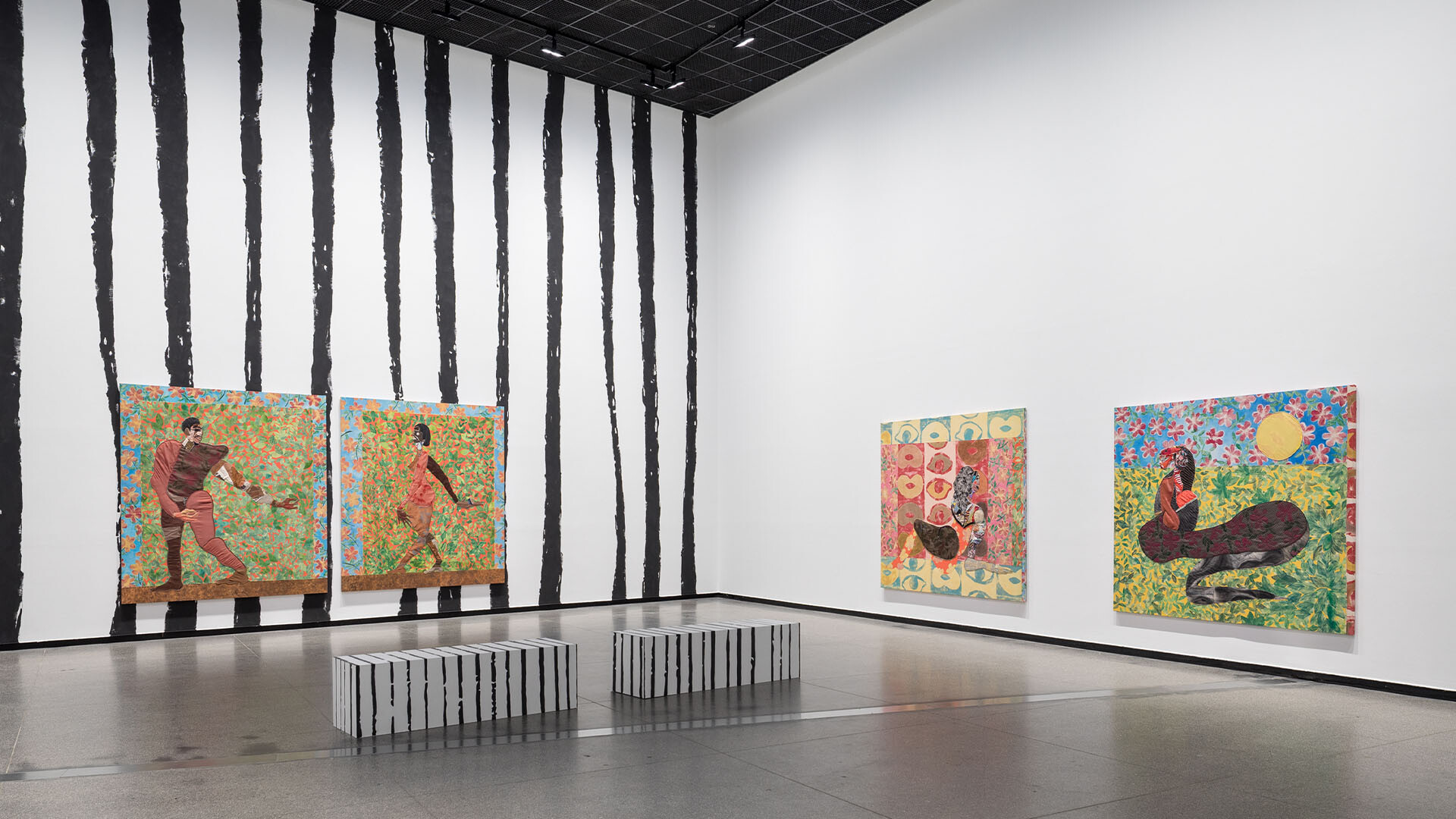
Skin Tight installation view, Australian Centre for Contemporary Art, Melbourne, 2025. Photograph: Andrew Curtis.
A faint soundtrack accompanies my visit to ACCA, the source of which remains a mystery as I make my way through the first two galleries. However, in the third gallery, I finally discover its source. It is coming from a three-channel video work, The Bigger Picture (2024) based on a 2021 live performance entitled Sounding Board. Self admits that when she devised Sounding Board, she harboured a “disinterest in performance art,” yet The Bigger Picture is a good accompaniment to her canvases, almost bringing their themes to life. Sounding Board was presented at the Jackie Robinson Bandshell in Harlem, the dome of the venue lit up with Self’s preferred chequerboards. In the videos, a Boney M cover band provides the soundtrack for a modern day, domestic drama—a joyous analogue of the chorus of a Greek tragedy. From what I could garner from the third channel, where the narrative plays out, The Bigger Picture tells the story of a couple (each played by two actors—mirrors again!). In the part I saw they were fighting, throwing around lines like “I don’t have time for your bullshit” and “I’m happy by my lonesome!”.
Chequers also variously feature on the costumes worn by the performers, designed in collaboration with UGG and later made available for sale to the discerning public. Having a video work in the show is valuable, as it breaks up the uniform medium of the rest of the works in Skin Tight. However, something about this UGG collab doesn’t sit right with me. There was no mention of the fact that outfits from Sounding Board were available for sale shortly after the work’s presentation, which undermines the veracity of the artist’s statement: “Sounding Board is an exploration into humanity relationship (sic), exploration in human relationships, performativity, and the multiplicity of self.” This must simply be an unfortunate typo, but the paucity of detail around the work’s origins left me somewhat disenchanted.
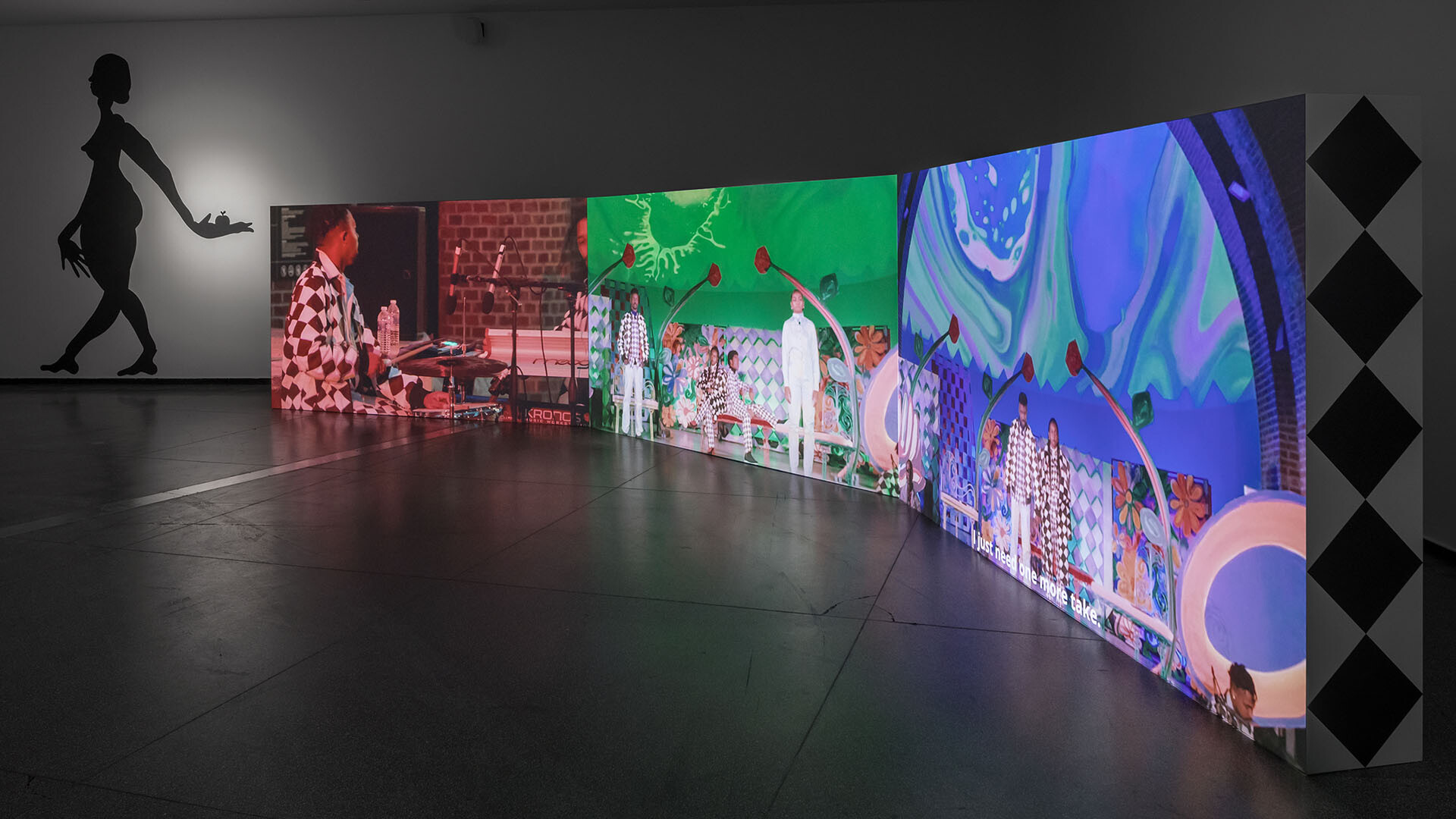
Tschabalala Self, The Bigger Picture 2024, installation view, Australian Centre for Contemporary Art, Melbourne, 2025. Courtesy the artist, Pilar Corrias, London, Galerie Eva Presenhuber, Zurich / Vienna and Petzel Gallery, New York. Photograph: Andrew Curtis.
Adam and Eve get a shadowy reprise in this gallery too, though it’s harder to make them out in the darkened space. Eve’s apple is spotlit, still untouched. Kara Walker’s influence looms large over these painted silhouettes. But while the formal similarity is striking, it feels like Self’s silhouettes are somewhat insubstantial outside their relationship with the corresponding works on canvas. Walker’s use of silhouettes, deeply grounded in the troubled history of American slavery, is a vital element of understanding her work. The silhouettes are the objects themselves, rather than shadows cast. By contrast, though the wall paintings remain visually striking, Self seems to only uses them to further her theory of yin and yang, “opposing yet conjoined forces,” like the chequerboards and the stripes. I wanted more. There is abundant room here, as with the consistent themes of mirroring, to explore the significance of the work beyond this limited artistic framework. Yet the didactics never stray far from the artist’s statements.
Despite the success of several of the pairings in Skin Tight, there are moments where attempts to place works in conversation do not succeed and seem a little forced. Take for example our friends in Dreamers, who bare themselves opposite a work titled The Voyeur (2021). This work depicts a collaged man staring out of the canvas, attended to by a lingering, indistinct phantasy-woman rendered in paint. While it’s a strong work, is it not enough for the viewer to be the voyeur of Dreamers? Is it really necessary to have another, rendered in fabric on canvas? The ubiquity of Self’s favoured motifs—chequerboards, six-petalled flowers, vibrant green leaves—means that most of the works in Skin Tight sit comfortably together, offering stylistic continuity that carries us from one work to the next without great challenge or variation. These motifs are presented like wallpaper: I’m curious as to their significance, yet neither the didactics nor any broader exhibition marketing offers much insight.
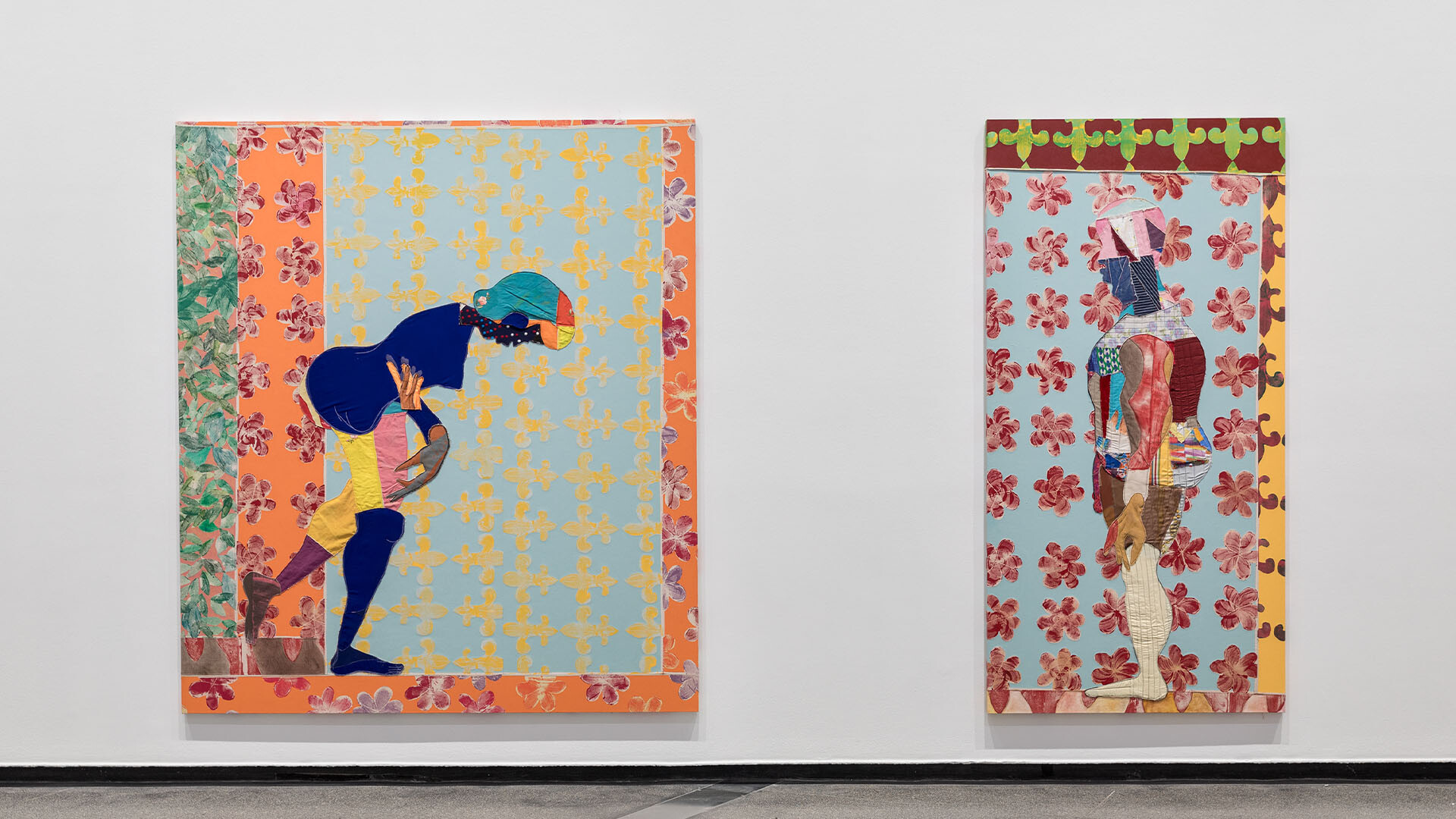
Tschabalala Self, Submission 2025 and Humility 2025, installation view, Australian Centre for Contemporary Art, Melbourne, 2025. Courtesy the artist, Pilar Corrias, London, Galerie Eva Presenhuber, Zurich / Vienna and Petzel Gallery, New York. Photograph: Andrew Curtis.
It is therefore perhaps unsurprising that the best work in the show grabs my attention for lack of these formal motifs. Standing out as soon as I enter the first gallery, Candy (2025) depicts a woman outstretched on a couch, a long shadow arching over her. The subtle mint green stripe of the couch complements the dark carmine room, and the bright pink of the doorway gives good structure to both the woman and the sinister shadow. Again, I’m reminded of Bacon, specifically his Study for Portrait of Henrietta Moraes on a Red Ground (1964), and the related Portrait of Henrietta Moraes (1966). There are several formal similarities between the works: Bacon’s subject also reclines on a stripy, green couch, and in the former, is presented against a bright red and orange background.
The last gallery features yet another pairing—two works, a woman and a man— entitled Submission (2025) and Humility (2025). Submission kneels down before Humility, and while the wall labels interpret this act of supplication as empowering, I must admit I fail to follow. Not everything has to be empowering. More interesting than these works though are the four little studies on paper on the opposite wall. These, especially the green-on-green Study 10 on Wood with Elevating Figure (2025), are a charming and well-earned reprieve from the consistent patterns, brilliant hues and large scale of the other canvases. Without all the trimmings, it’s a chance to inspect Self’s formal methods and motives, to get a sense for how she constructs her bodies.
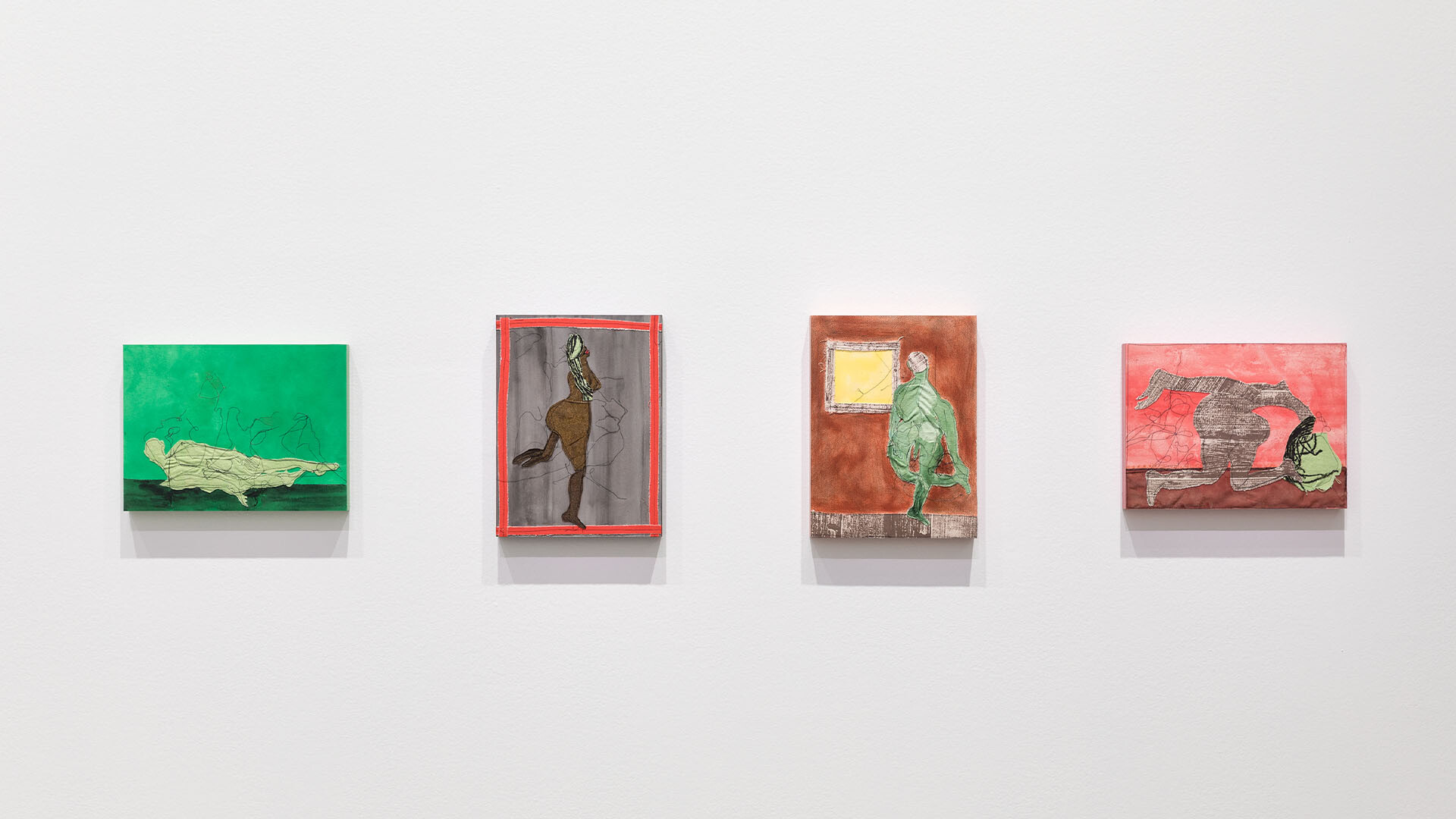
Skin Tight installation view, Australian Centre for Contemporary Art, Melbourne, 2025. Photograph: Andrew Curtis.
Skin Tight is vibrant and energetic. It’s a pleasant, feel-good show, complete with catchy music and digestible work. And while it’s nice to be introduced to a new, voguish American artist, when leaving the gallery I can’t help but feel that Skin Tight is not as substantial an exhibition I’ve come to expect from the nation’s leading Kunsthalle. I was curious about Self’s work, and excited to have the chance for a deep-dive into the serious themes she engages with. There’s so much material—agency and stereotypes, mirrors and shadows—yet wherever I looked it was difficult to get a true sense of the works’ significance.
Hugh Magnus is a writer based in Narrm/Melbourne
